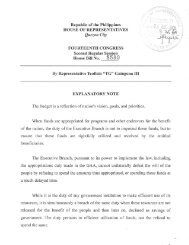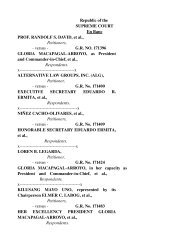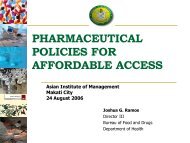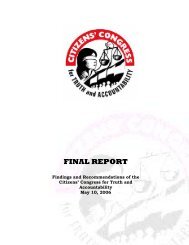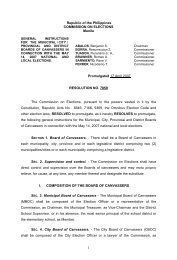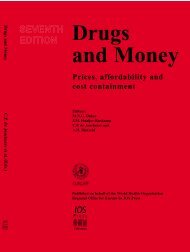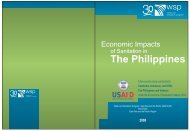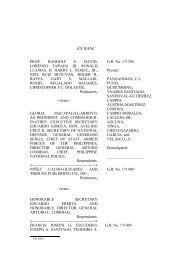Decentralization and Corruption in the Philippines
Decentralization and Corruption in the Philippines
Decentralization and Corruption in the Philippines
Create successful ePaper yourself
Turn your PDF publications into a flip-book with our unique Google optimized e-Paper software.
objective than o<strong>the</strong>r measures we use, we exam<strong>in</strong>e <strong>the</strong> effects of both household <strong>and</strong><br />
public officials perceptions of corruption on <strong>the</strong> knowledge variable. The effect of<br />
household corruption perceptions is significant <strong>in</strong> weighted least squares (regression 8.1)<br />
but only marg<strong>in</strong>ally significant if <strong>the</strong> r<strong>and</strong>om effects estimator is used (regression 8.2).<br />
The effect of public officials perceptions of corruption are clearer <strong>and</strong> highly significant<br />
(at 1%) <strong>in</strong> both <strong>the</strong> WLS <strong>and</strong> <strong>the</strong> r<strong>and</strong>om effects estimation. Unsurpris<strong>in</strong>gly if we use <strong>the</strong><br />
comb<strong>in</strong>ed <strong>in</strong>dex on corruption, <strong>the</strong> effect rema<strong>in</strong>s highly significant at 1%. The<br />
coefficient of –0.23 means that a one st<strong>and</strong>ard deviation <strong>in</strong>crease <strong>in</strong> corruption reduces<br />
knowledge of required immunizations by 5.5 or 1/4 th of a st<strong>and</strong>ard deviation.<br />
Income was also significant <strong>in</strong> <strong>the</strong> regression were <strong>in</strong>come, with more correct<br />
responses <strong>in</strong> municipalities with richer households. Delays <strong>in</strong> salary payments at <strong>the</strong><br />
municipal –but not <strong>the</strong> facility- level also seemed to adversely affect knowledge, perhaps<br />
due to <strong>the</strong> dra<strong>in</strong> of <strong>the</strong> most qualified personnel.<br />
IV.2 <strong>Corruption</strong>, wait<strong>in</strong>g time <strong>and</strong> household satisfaction rat<strong>in</strong>gs<br />
Next we asked <strong>the</strong> users of government services –households-, about both <strong>the</strong>ir<br />
satisfaction with government services <strong>and</strong> a somewhat more precise question on wait<strong>in</strong>g<br />
time. Reassur<strong>in</strong>gly <strong>the</strong> answers to <strong>the</strong>se questions are negatively correlated with each<br />
o<strong>the</strong>r <strong>and</strong> we also use an <strong>in</strong>dex composed of both questions. We created <strong>the</strong>se <strong>in</strong>dices on<br />
satisfaction <strong>and</strong> wait<strong>in</strong>g time after filter<strong>in</strong>g out <strong>the</strong> propensity to compla<strong>in</strong> us<strong>in</strong>g<br />
equations 4.1 <strong>and</strong> 4.2. Perceptions of national corruption, which are meant to capture <strong>the</strong><br />
“gripe” bias are only significant for <strong>the</strong> satisfaction question. This suggests that it might<br />
be better to ask precise ra<strong>the</strong>r than subjective questions to m<strong>in</strong>imize respondent bias. Of<br />
course precise questions may capture less relevant <strong>in</strong>formation, so it may be best to ask<br />
both precise <strong>and</strong> general questions, which is what we do. The best measure may well be<br />
based on both measures <strong>and</strong> we construct a third measure based on both satisfaction <strong>and</strong><br />
wait<strong>in</strong>g time. If <strong>the</strong> measure were better we would expect <strong>the</strong> equation predict<strong>in</strong>g it to<br />
have a better fit, <strong>in</strong>deed <strong>the</strong> fit of <strong>the</strong> equation for <strong>the</strong> composite <strong>in</strong>dex is better than for<br />
ei<strong>the</strong>r component (0.32 ra<strong>the</strong>r than 0.22 or 0.29).<br />
We present <strong>the</strong> results on <strong>the</strong> determ<strong>in</strong>ants of performance measures based on<br />
household responses <strong>in</strong> Table 9. These equations are estimated at <strong>the</strong> barangay level.<br />
This is <strong>the</strong> best way to estimate <strong>the</strong> equation because households were asked to rate <strong>the</strong><br />
15



